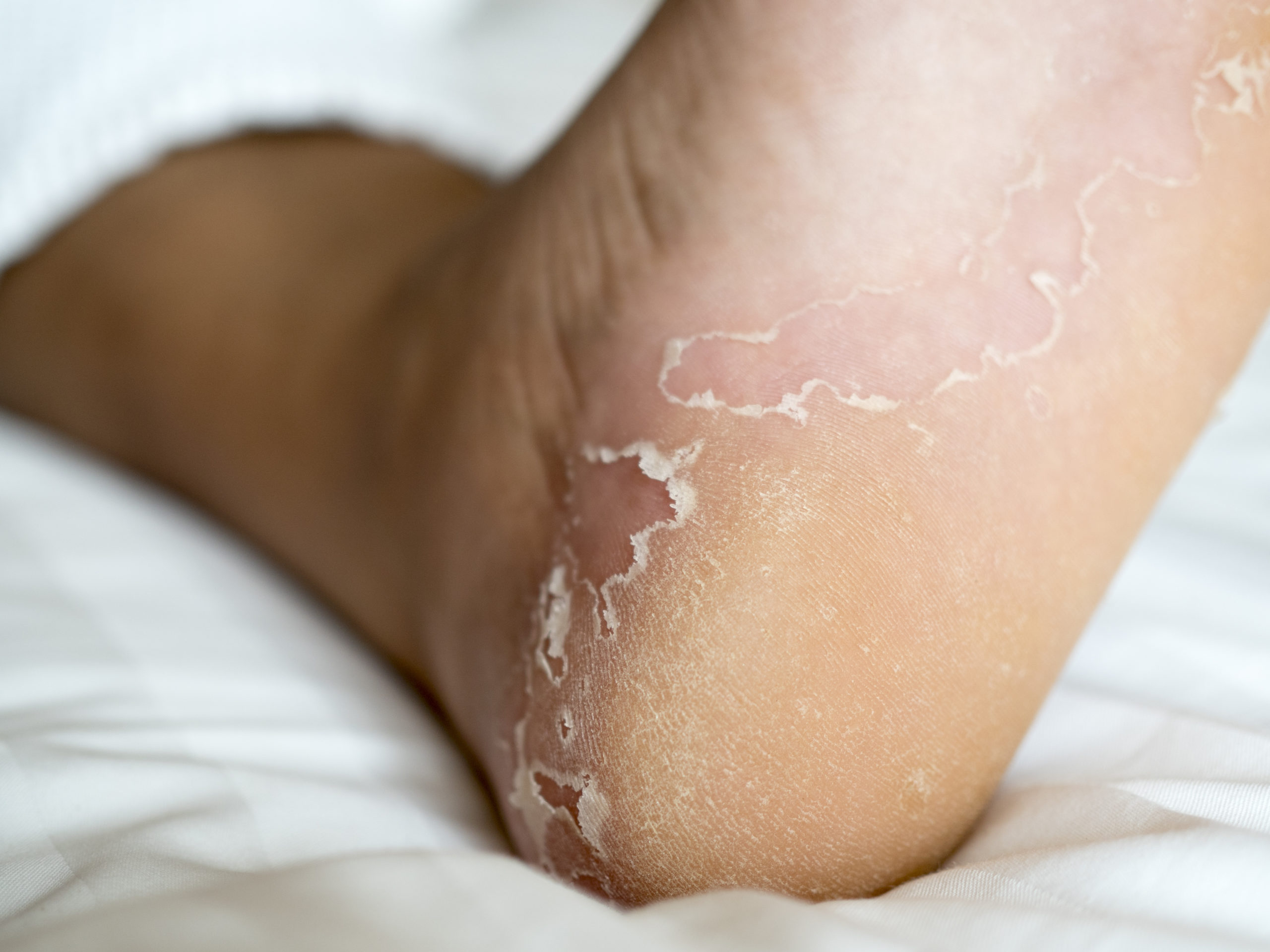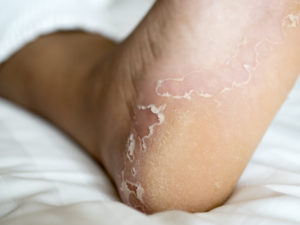
 While for some, the thought of coming home, taking off your shoes and socks and putting your feet up after a long day feels like bliss, many Australians opt to keep their feet hidden because of peeling skin on the bottoms of their feet.
While for some, the thought of coming home, taking off your shoes and socks and putting your feet up after a long day feels like bliss, many Australians opt to keep their feet hidden because of peeling skin on the bottoms of their feet.
As “I don’t know why my feet do that, they’re always peeling” is a sentence we hear often in our podiatry clinics, today we thought we’d share our four most common causes of peeling feet – and what you can do to remedy the problem.
Athlete’s Foot: Symptoms and Causes
Athlete’s foot is a fungal skin infection that spreads easily in places like pools, locker rooms, public showers and anywhere with wet floors. You can also get it from direct contact or sharing socks and shoes. If you spend your days doing physical activity or in a demanding occupation in shoes that don’t breathe easily and instead accumulate moisture, you may be most vulnerable, falling into the athlete category from where the name Athlete’s foot is coined.
One of the key features of Athlete’s foot is peeling skin, often starting as tiny ‘blisters’ in the arch or saturated skin between the toes. Before you know it, the soles of your feet and the spaces between the toes may be peeling – and with it, you’ll likely experience burning, itching, stinging, or even a foul odour.
Treating Athlete’s Foot
If you suspect your peeling feet and toes to be the victim of a fungal infection, you must:
- Treat the fungus using an anti-fungal product on your feet recommended by your podiatrist
- Remove any environmental elements that encourage fungal growth, like spending long days in warm, damp shoes, and always dry your feet and between the toes well after showering
- Prevent re-infection – as the fungal spores will continue to linger in your shower, home, shoes and socks, so you must take care to not re-infect after treatment
Dry Skin: Symptoms and Causes
 Dry skin is a common cause for peeling feet. The cause of dry skin on the feet can either be external or internal. External causes include sunburn, prolonged hot showers (or baths), low humidity (inside or outside your home), dehydration, smoking and stress. Internal causes include a genetic predisposition (so it runs in the family), your age, health and other medical conditions like thyroid problems, and whether you suffer from an underlying cause or not, you could be making your dry skin condition worse unknowingly.
Dry skin is a common cause for peeling feet. The cause of dry skin on the feet can either be external or internal. External causes include sunburn, prolonged hot showers (or baths), low humidity (inside or outside your home), dehydration, smoking and stress. Internal causes include a genetic predisposition (so it runs in the family), your age, health and other medical conditions like thyroid problems, and whether you suffer from an underlying cause or not, you could be making your dry skin condition worse unknowingly.
Treating Dry Skin
Fortunately, there are plenty of solutions for dry feet, and it’s all about addressing the cause of the dryness paired with some good skin hydration using a good moisturising cream like this.
If your body is dehydrated, focus on getting an adequate water intake daily. If you live in a dry climate, consider whether a humidifier could be good for your overall skin health (and not just for your feet!).
The best thing to do to treat peeling skin is to moisturise frequently – at least once a day – especially right after a warm shower or bath. When your skin is damp, it more readily soaks in the moisturiser, which will help solve the dryness, and the peeling, sooner. For maximum impact, put on socks directly after moisturising.
Atopic Dermatitis (Eczema): Symptoms and Causes
Medically known as atopic dermatitis, the most common symptom of eczema is a scaly, itchy red rash that is often accompanied by dry skin, cracking, and peeling – while making you more prone to skin infections.
Eczema is not contagious, and the cause is poorly understood, but linked to a genetic condition that affects your skin’s ability to protect itself from bacteria and allergens. It is more common in people who also suffer from asthma or allergies.
Treating Eczema
As eczema has a similar clinical presentation to a number of other skin conditions, it’s important to first get a confirmed diagnosis. Your My FootDr podiatrist can help you rule out a number of other causes, assess whether your shoes or foot biomechanics are playing a role in the irritation of the skin, and make recommendations towards the best treatment for your feet.
Psoriasis: Symptoms and Causes
Psoriasis on the feet is known as palmoplantar psoriasis, and causes red, flaking patches on the skin that are raised, scaly and look like they’re peeling.
While the exact cause of psoriasis is poorly understood, it is related to the inflammation of the skin and an overgrowth of skin cells. Usually, people with psoriasis experience flares during which the symptoms get worse. These flares may be triggered by cold weather, alcohol or drug consumption, stress, infection or illness, or skin irritation from other substances or materials like chemicals or clothing.
Treating Psoriasis
The approach to managing psoriasis is similar to managing eczema. You want to discourage significant damage and breaks in the skin as much as possible, so using gentle, sensitive moisturisers can help maintain the integrity of the skin. Medicated skincare creams can also help.
Peeling Feet In Kids: Juvenile Plantar Dermatosis
If it’s your child that has peeling skin, they may have juvenile plantar dermatosis. This is a common and ongoing dry skin condition that affects kids aged between 3 and 14. The cause may be genetic, related to climate, a result of excessive sweating, or related to their footwear materials or sizing that leads to repetitive rubbing. Aside from peeling, it can also cause painful cracks, leaving the feet vulnerable to infection.
Treating Juvenile Plantar Dermatosis
Effective treatment includes addressing the cause – where it is known and identified. Make sure your child’s shoes fit correctly and aren’t causing excess friction. Always wearing socks with enclosed footwear can help – as can choosing socks and shoes that aren’t made of synthetic materials. Urea-based moisturisers or barrier creams can also help. If painful cracks develop, let them heal without irritation, and monitor your child’s feet for signs of infection.
Worried about your or your child’s peeling feet?
If you’re worried, or the peeling is causing discomfort, pain or embarrassment, our experienced podiatry team are here to help. My FootDr has clinics around Australia dedicated to helping you stay healthy on your feet, so you can lead your best life. Book your appointment online by clicking here or call us on 1800 FOOT DR.


